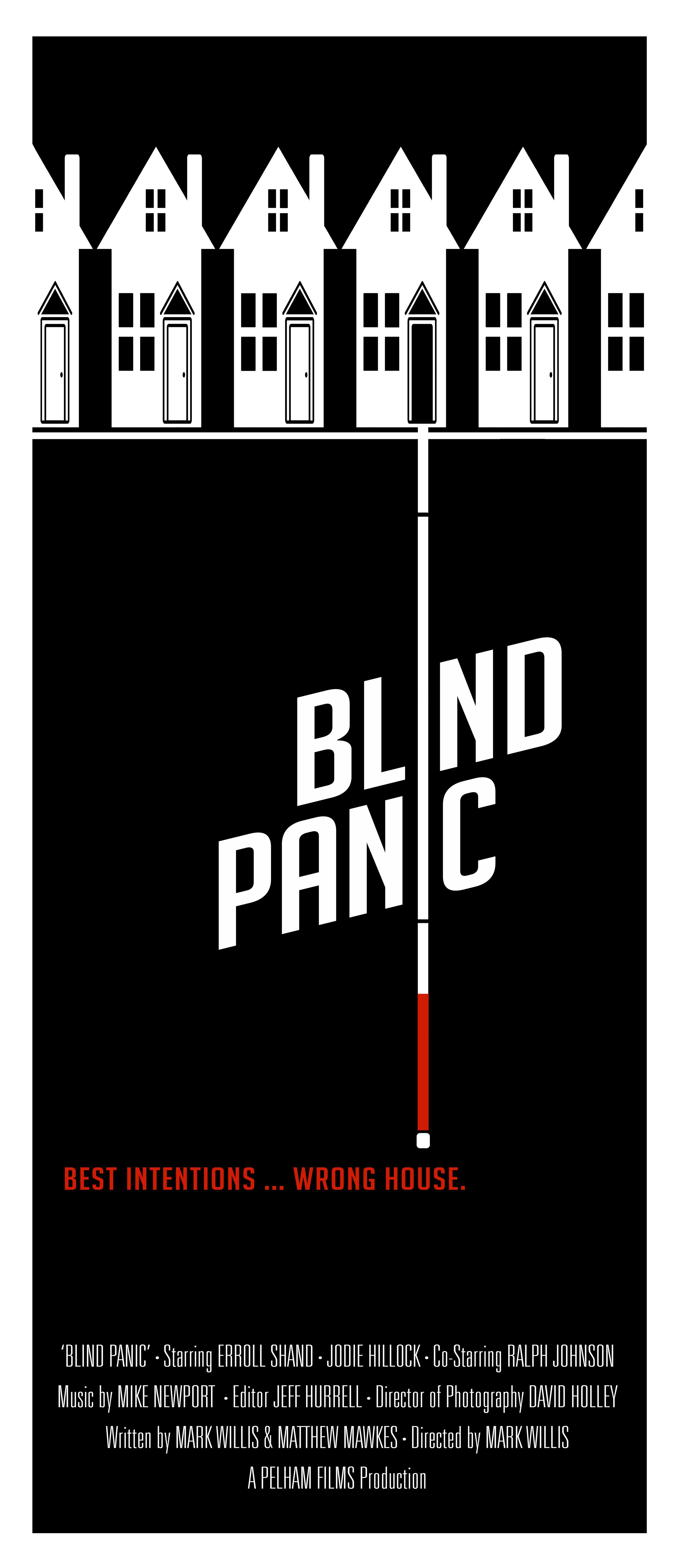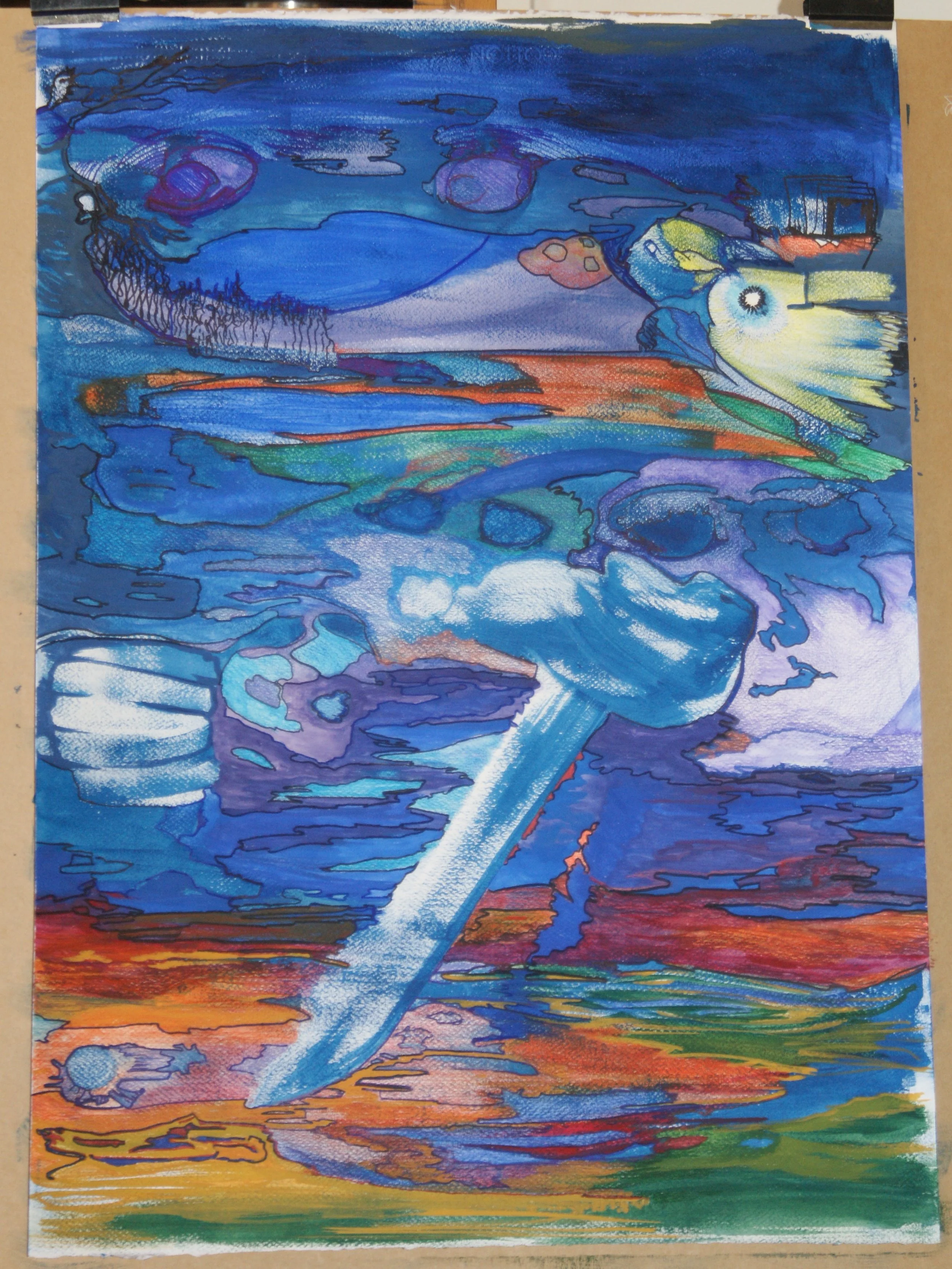Kickstarting Blind Panic
The only way to make your first movie is to greenlight yourself. But it’s going to take money – LOTS of money – to make your vision come to life. Mostly by making your relatives sit down in front of a computer and get out their credit card.
Elongated daybill poster for Blind Panic Kickstarter rewards.
Background: Blind Panic is the debut feature film of director Mark Willis and producer Matthew Mawkes. The film came about when Mark and Matthew decided to fulfil a long-held dream of making a quality genre movie in their own backyard. Needing a low-budget idea, Mark came up with a story about a man on home detention, while Matthew hatched a story about a blind woman trapped in suburbia. The ideas merged and Blind Panic was born.
Blind Panic was funded by a Kickstarter campaign and filmed on a shoestring budget in Wellington, New Zealand, over 21 days, in April-May 2017. It then took several years of editing and re-shoots to turn Blind Panic into the crime thriller Mark and Matthew originally envisioned. The project also faced a major set-back with the tragic killing of Mark in May 2023. Fortunately, Mark was able to sign off a cut of the film before his death.
This has been a filmmaking journey with ups and downs like no other. But the final product is a crime thriller Mark would be proud of.
After self-actualising ourselves as screenwriters, Mark and I had to figure out how to turn our script, which we eventually entitled Blind Panic, into a movie. We both knew that the powers that be, which in New Zealand is the government-sponsored New Zealand Film Commission, would never fund us, as despite Mark’s successful short film Splinter, we were nobodies, and the NZFC is like an exclusive club where you’re either in with the cool kids, or you’re out. But one thing the NZFC did have was a seed fund called Premiere Pathways. We thought we’d apply for funds to create a trailer and test scene for our movie, that we could then use for a crowdfunding campaign, and go from there.
To our great surprise, we got the funds – $8,717.50 to be exact – with a note from the NZFC saying something along the lines of, “We don’t like you, but we do like that you’re planning to raise the funds to make your movie all by yourself, so good luck”. We then set about getting ready for our very first Blind Panic shoot.
This was my first foray into producing and I quickly learned that the main task for a producer is to talk people into things. This is especially true when you have so few funds, and the first decision we made was to spend the majority of what we had on the cast. Reason being – the first thing an audience will notice about a low-budget movie is bad acting, so you’ve got to get the right people. And so, after much searching, we found our key players – Erroll Shand, Jodie Hillock and Ralph Johnson, who played Louis, Madeleine and our antagonist, Mr. Prescott, respectively.
All took a bit of convincing, but I think it was Erroll who finally said he’d be willing to ‘breathe life’ into his character after we explained our earnest intentions. That was 2015 – which reveals the very unusual situation we’ve had in that our cast have been living in their characters’ shoes for 10 years!
Mark and I having fun on set during the promo shoot. Mark loved this shoot – especially that rustic garage location – but the same can’t be said for principal photography.
Our trailer and test scene were good, with strong acting, art direction, and cinematography, but looking back the test scene plays quite mean-spirited. Louis is a total bastard! This was in the days preceding the me-too movement, so perhaps we’re looking back through a different lens, and Blind Panic has never been a ‘woman in peril’ flick – Madeleine is a powerful character in her own right. But it’s interesting to look back and see how you can transform your script entirely through on-set interpretation and editing. Blind Panic the feature film presents a much more complicated Louis character, but the shooting script is not far removed from our test footage.
Test footage from Blind Panic where Louis is a total bastard! Great performances by Erroll Shand and Jodie Hillock, and the dialogue is remarkably similar to the feature, but the tone has changed.
In the same way we self-actualised ourselves as screenwriters, we knew that a Kickstarter campaign would be the way to greenlight ourselves as filmmakers. Nobody else would do it for us – so using our test material we set a lofty goal ($40,000), promised lots of great rewards, and launched our Kickstarter campaign in September 2016.
Apart from making the feature film itself, this was the hardest thing we’ve ever undertaken. Fundraising is bloody hard work, and incredibly disheartening, because the people you target – i.e. people with money – don’t donate, while those who can’t really afford to, do. Maybe that shouldn’t have surprised us, but Mark and I really put our heart and soul on the line, so it was still disappointing, nonetheless.
Lobby cards for Blind Panic Kickstarter rewards.
I want to take a moment to talk about our rewards because I think they’re pretty special. Beyond the usual perks – like a thank you, a movie download, or a ticket to the premiere – we created retro Australian-style daybill posters (13” x 30”). These elongated posters, unique to Australia from the 1920s onward, have a distinct vintage charm and I think they just look cool. We also designed lobby cards (11” x 14”), a classic promotional tool once displayed in theatre lobbies. Traditionally printed in sets of eight, we created four for Blind Panic.
Adding to the mix, artist Debra Turnbull painted four original works inspired by stills from the Blind Panic test footage, drawing influence from the horror anthology Night Gallery. I’ve never seen a crowdfunding campaign offer paintings before, so I was proud to sell two for $500 each. The one reward we couldn’t quite convince anyone to buy was a unique opportunity: a black-and-white portrait shot with an old-school large-format film camera (the kind where the photographer ducks under a black cloth), taken by our still photographer at the time, Antony Kitchener.
Some very interesting paintings by Debra Turnbull.
Never mind – I was proud to give anything a shot when it came to our rewards, and that same mindset applies to crowdfunding in general. You just have to put yourself out there – give everything a try. I stood in front of hundreds at a New Zealand Film Society screening, talking about Blind Panic and trying to convince cinephiles to support our cause. We even played our trailer before Don’t Breathe at the Roxy Cinema, placing flyers on every seat to encourage donations from the genre-loving audience. Sometimes, these efforts take a lot of energy, and all you walk away with is $20. It’s like throwing 20 darts at once and hoping one of them hits the bullseye.
Slowly but surely, we crept toward our goal – and then we just flatlined. This was scary, because Kickstarter employs an all-or-nothing system – you either hit your target and get everything, or you get nothing at all. And so, I took a week off work and drove across New Zealand for a Blind Panic roadshow where I tried to convince everyone I could to donate to our campaign, trying to drum up media along the way. Even then, donations mostly came from friends and family – that’s just how crowdfunding seems to work – but it helped us inch further toward our goal.
As people started to see that we were becoming successful, new funds appeared, and we finally hit our goal. At the time, we were the most successful New Zealand-based feature film campaign on Kickstarter, and we happily took that little feather in our cap.
And then it dawned on us that we would now need to actually make our movie. That greenlight was shining bright, and it was onwards into oblivion – the pain, pressure, stress and difficulty of bringing our vision to life. In other words, filmmaking!
MATTHEW MAWKES







